#6: CHEOPS solar arrays tested and built
16 December 2016
Over the last 10 months, the CHEOPS solar cell assemblies have been put through their paces in the test facilities at industry and in the Solar Generator Laboratory of the Power Systems Division (TEC-EP) at the European Space Research and Technology Centre (ESTEC) as part of the qualification campaign. In parallel, the flight solar arrays have been manufactured and delivered.As with many ESA missions, the Sun is the sole source of power for CHEOPS and for this reason the solar arrays and their constituent solar cells play a critical role in the operation of the satellite.
The CHEOPS solar arrays cover a total geometrical area of about 2.7 m2 with an effective active area of just over 2.1 m2. The 3 fixed panels are body mounted with an angle of 67 degrees between them to provide the best possible illumination by the Sun at a given spacecraft attitude.
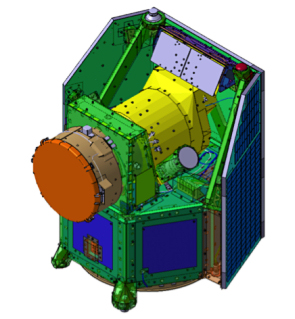 |
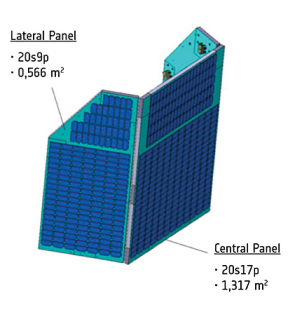 |
| CHEOPS spacecraft – schematic. Credit: Airbus DS – Spain |
CHEOPS solar panels. Credit: Airbus DS – Spain |
The individual solar cell assemblies comprise AzurSpace 3G30 Triple Junction GaAs/Ge cells, and are provided by Leonardo-Finmeccanica. The 3G30 is a new generation of more efficient cells, which were initially qualified with respect to lifetime requirements only for geostationary orbit missions in the ESA Meteosat Third Generation (MTG) Programme.
CHEOPS will be placed into a dawn-dusk circular Sun-synchronous orbit at an altitude between 650 km and 800 km (the tradeoff for this has still to be finalized).
Due to stringent thermal stability requirements at instrument level, the satellite will roll around the line-of sight to ensure that instrument radiators are always pointing towards cold space. This, combined with the attitude range, means that the solar cells will be subjected to a range of temperatures and thermal variations that are much larger than those for which the cells were previously qualified, and this is the reason for this 'delta-qualification' that was carried out at ESTEC.
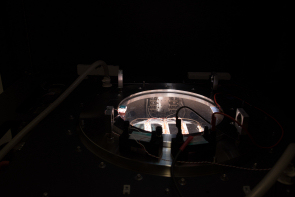 |
| CHEOPS solar cells. Credit: ESA – C. Carreau |
The Solar Array electrical qualification campaign was split into two parts: the first, a so-called 'Group F' test (as per ECSS-E-ST-20-08 – Photovoltaic assemblies and components standard), focused on life-time testing at individual solar-cell level under the worst-case operating conditions. This test is designed to ensure that any degradation in electrical performance by the end of the CHEOPS mission lifetime is within strict limits; the second, the design validation test, focused on the thermo-mechanical integrity of the solar cell assemblies, which were thermally cycled to verify that thermal variations that will be experienced in orbit do not produce detrimental effects (for example, lead to failure or performance degradation).
Both test activities were conducted on solar array test units, represented by smaller scale panels.
3G30 solar cells Group F delta qualification
The Group F test was undertaken at ESTEC in the Vacuum Solar Cell Illumination Facility (VSCIF).
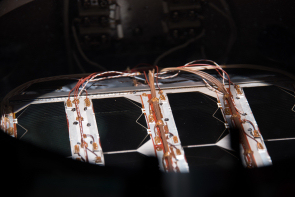 |
| CHEOPS solar cells – close-up view. Credit: ESA – C. Carreau |
The solar cell assembly was illuminated by a solar simulator whilst heated to three different temperatures, each representative of those experienced in operations. The actual temperature values were scaled in a precisely prescribed way relative to the actual operational values in order to accelerate ageing effects, in this way enabling a test campaign representative of the 3.5 year nominal mission lifetime to be completed in a few months.
The one solar constant illumination that will be experienced by CHEOPS is simulated by a single, external 2.5 kW Xenon arc lamp that is reflected into the VSCIF via focusing and collimating optics and a series of reflecting mirrors. Reference solar cells are used to calibrate and monitor the flux incident on the solar cells.
The campaign was split into three parts: 2000 hours at 140 deg C, 2000 hours at 160 deg C and 2090 hours at 175 deg C. Degradation in the cell maximum power and short circuit current was measured to be less than 2% of the 'Beginning of Life' values, which is below the required acceptance criteria of 3% degradation.
Thermo-mechanical qualification
Based on a thorough thermal analysis initiated in ESA and consolidated in Airbus DS Spain, the CHEOPS qualification environment was defined, specifying a number of thermal cycles to be performed on the test device across specific temperature ranges. A total of almost 23000 cycles were required to achieve qualification, with temperatures ranging from 160 deg C to -130 deg C.
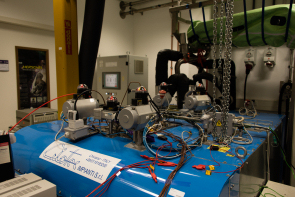 |
| A test facility at ESTEC. Credit: ESA – C. Carreau |
Most of the thermal cycling activities were performed in Leonardo Italy, except for one set of cycles, which took place in ESTEC, so as to decrease the test duration, since the ESTEC test facility allows for faster implementation of the thermal cycles.
As a result of this test campaign, aggregating activities both in Leonardo and ESTEC, the electrical and thermo-mechanical qualification could be demonstrated before the end of 2016.
As a result of these tests, the CHEOPS solar arrays and their constituents (in particular, the solar cells and diodes) are now qualified for the CHEOPS mission.
In parallel, manufacturing of the flight solar arrays has been completed and the related acceptance tests positively concluded, leading to their delivery to the spacecraft prime contractor before the end of this year.
About CHEOPS
CHEOPS is an ESA mission implemented in partnership with Switzerland, through the Swiss Space Office (SSO). The University of Bern leads a consortium of 11 ESA Member States contributing to the mission and represented in the CHEOPS Science Team. ESA is the mission architect responsible for overall mission definition and procurement of the spacecraft and launch. ESA is also responsible for early operations phase that will be executed by the spacecraft contractor, EADS CASA Espacio S.L., which is part of Airbus Defence and Space. The science instrument is led by the University of Bern, with important contributions from Austria, Belgium, Germany and Italy. Other contributions to the science instrument, in the form of hardware or science operations, are provided by Hungary and by France, Portugal, Sweden and the United Kingdom respectively. Following successful in-orbit commissioning of the spacecraft, responsibility for operations will be taken over by the CHEOPS Mission Consortium, with the Mission Operations Centre under the responsibility of Spain and the Science Operations Centre led by and located at the University of Geneva, Switzerland.





